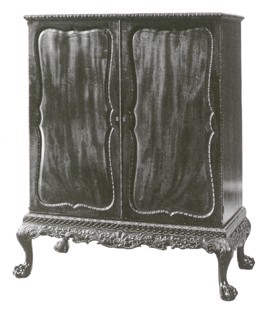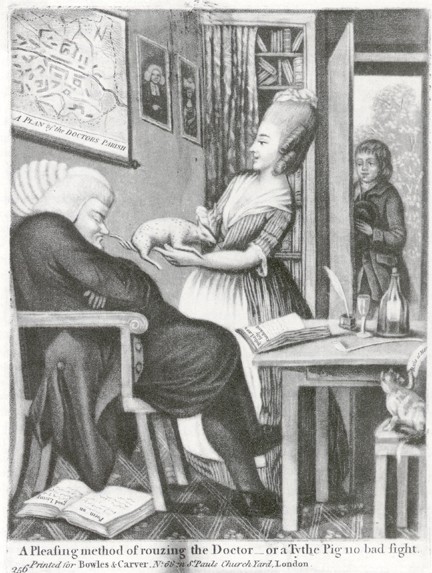
Design for a state bed in Daniel Marot, Second Livre d'Apartments, ca. 1702. (Dumbarton Oaks, Trustees for Harvard University, Studies in Landscape Architecture.)

Cover for a side chair, plate printed in England by Robert Jones, Old Ford, 1761—1780. Cotton with wool and cotton fringe. (Colonial Williamsburg Foundation, acc. 1963—36, 12.)

Cushion cover for an easy chair, plate printed in England by Robert Jones, Old Ford, 1761—1780. Cotton with wool and linen binding over the seams and cotton and wool fringe. (Colonial Williamsburg Foundation, acc. 1963—36, 10.)

Side chair, Philadelphia, 1769—1770. Mahogany with white cedar. H. 37", W. 24", D. 24'. (Colonial Williamsburg Foundation, acc. 1964—680. )

Easy chair, Massachusetts, 1760—1770. Mahogany with maple; linen foundation upholstery. H. 47 1/2", W. 34", D. 26". (Chipstone Foundation, ace. 1991. 2; photo, Hans Lorenz.)

Detail of the upholstery evidence on the easy chair illustrated in fig. 5. (Chipstone Foundation; photo, Hans Lorenz.) The only period tack evidence on the stiles and seat rails is for the linen cover. During conservation, an eighteenth-century pin was found between the inner back and side panels. The loose cover may have been pinned temporarily in this area.

Detail of the arm of the easy chair illustrated in fig. 5. (Chipstone Foundation; photo, Hans Lorenz.) This view shows the original grass roll, curled horsehair stuffing, and linen cover (pulled back). The tack holes in the cover match those on the arm; there is no tack or nail evidence or stitching in the arm area that would indicate fixed upholstery.

Easy chair, Rhode Island, 1785—1795. Cherry with maple and white pine; linen foundation upholstery. H. 46", W. 30", D. 26 1/2". (Colonial Williamsburg Foundation, gift of Mrs. Eleanor U. Sargent, acc. 1977—215.)

Cover for the back of an armchair, England, 1680ñ1700. Embossed leather. H. 30", W. 26". (Colonial Williamsburg Foundation, acc. 1954—985.)

Cover for a table, England, 1675—1700. Embossed leather. H. 1 1/2", D. 27". (Colonial Williamsburg Foundation, acc. 1966—415, 2.)

Commode cover, England, 1765-1775, Embossed leather. Dimensions not recorded. (Museum of Leathercraft; photo, Victoria and Albert Museum.)

Clothespress attributed to Giles Grendey, London, 1735—1745. Mahogany with oak and deal. H. 65 1/4", W. 52 1/2", D. 27 1/2". (Colonial Williamsburg Foundation, ace. 1956—298.)

Interior of the clothespress in fig. 12 showing sliding trays with nail holes and fragments of tape trapping green baize. (Photo, Colonial Williamsburg Foundation.)

Detail of the green baize trapped beneath nail heads on the sliding trays of the clothespress in figs. 12, 13. (Photo, Colonial Williamsburg Foundation.)

"A Gentleman's Secretary" from Thomas Sheraton's The Cabinet-Maker and Up holsterer's Draming-Book (1802). (Courtesy, The Winterthur Library: Printed Books and Periodical Collection.)

Desk-and-bookcase attributed to the Anthony Hay shop, Williamsburg, 1765—1770. Walnut with yellow pine and walnut. H. 95 1/2", W . 39 1/8 ", D. 20 3/8". The silk curtains are reproductions. (Colonial Williamsburg Foundation, acc. 1978—9.)

A Pleasing Method of Rouzing the Doctor, printed for Bowles and Carver, London, 1765—1775. Mezzotint. 10 1/2" x 8 1/2". (Colonial Williamsburg Foundation, acc. 1941—230.)
